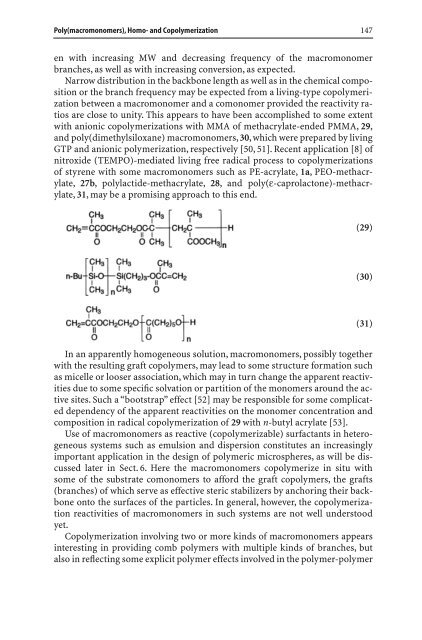142 Advances in Polymer Science Editorial Board: A. Abe. A.-C ...
142 Advances in Polymer Science Editorial Board: A. Abe. A.-C ...
142 Advances in Polymer Science Editorial Board: A. Abe. A.-C ...
Create successful ePaper yourself
Turn your PDF publications into a flip-book with our unique Google optimized e-Paper software.
Poly(macromonomers), Homo- and Copolymerization 147<br />
en with <strong>in</strong>creas<strong>in</strong>g MW and decreas<strong>in</strong>g frequency of the macromonomer<br />
branches, as well as with <strong>in</strong>creas<strong>in</strong>g conversion, as expected.<br />
Narrow distribution <strong>in</strong> the backbone length as well as <strong>in</strong> the chemical composition<br />
or the branch frequency may be expected from a liv<strong>in</strong>g-type copolymerization<br />
between a macromonomer and a comonomer provided the reactivity ratios<br />
are close to unity. This appears to have been accomplished to some extent<br />
with anionic copolymerizations with MMA of methacrylate-ended PMMA, 29,<br />
and poly(dimethylsiloxane) macromonomers, 30, which were prepared by liv<strong>in</strong>g<br />
GTP and anionic polymerization, respectively [50, 51]. Recent application [8] of<br />
nitroxide (TEMPO)-mediated liv<strong>in</strong>g free radical process to copolymerizations<br />
of styrene with some macromonomers such as PE-acrylate, 1a, PEO-methacrylate,<br />
27b, polylactide-methacrylate, 28, and poly(e-caprolactone)-methacrylate,<br />
31, may be a promis<strong>in</strong>g approach to this end.<br />
(29)<br />
(30)<br />
(31)<br />
In an apparently homogeneous solution, macromonomers, possibly together<br />
with the result<strong>in</strong>g graft copolymers, may lead to some structure formation such<br />
as micelle or looser association, which may <strong>in</strong> turn change the apparent reactivities<br />
due to some specific solvation or partition of the monomers around the active<br />
sites. Such a “bootstrap” effect [52] may be responsible for some complicated<br />
dependency of the apparent reactivities on the monomer concentration and<br />
composition <strong>in</strong> radical copolymerization of 29 with n-butyl acrylate [53].<br />
Use of macromonomers as reactive (copolymerizable) surfactants <strong>in</strong> heterogeneous<br />
systems such as emulsion and dispersion constitutes an <strong>in</strong>creas<strong>in</strong>gly<br />
important application <strong>in</strong> the design of polymeric microspheres, as will be discussed<br />
later <strong>in</strong> Sect. 6. Here the macromonomers copolymerize <strong>in</strong> situ with<br />
some of the substrate comonomers to afford the graft copolymers, the grafts<br />
(branches) of which serve as effective steric stabilizers by anchor<strong>in</strong>g their backbone<br />
onto the surfaces of the particles. In general, however, the copolymerization<br />
reactivities of macromonomers <strong>in</strong> such systems are not well understood<br />
yet.<br />
Copolymerization <strong>in</strong>volv<strong>in</strong>g two or more k<strong>in</strong>ds of macromonomers appears<br />
<strong>in</strong>terest<strong>in</strong>g <strong>in</strong> provid<strong>in</strong>g comb polymers with multiple k<strong>in</strong>ds of branches, but<br />
also <strong>in</strong> reflect<strong>in</strong>g some explicit polymer effects <strong>in</strong>volved <strong>in</strong> the polymer-polymer
















